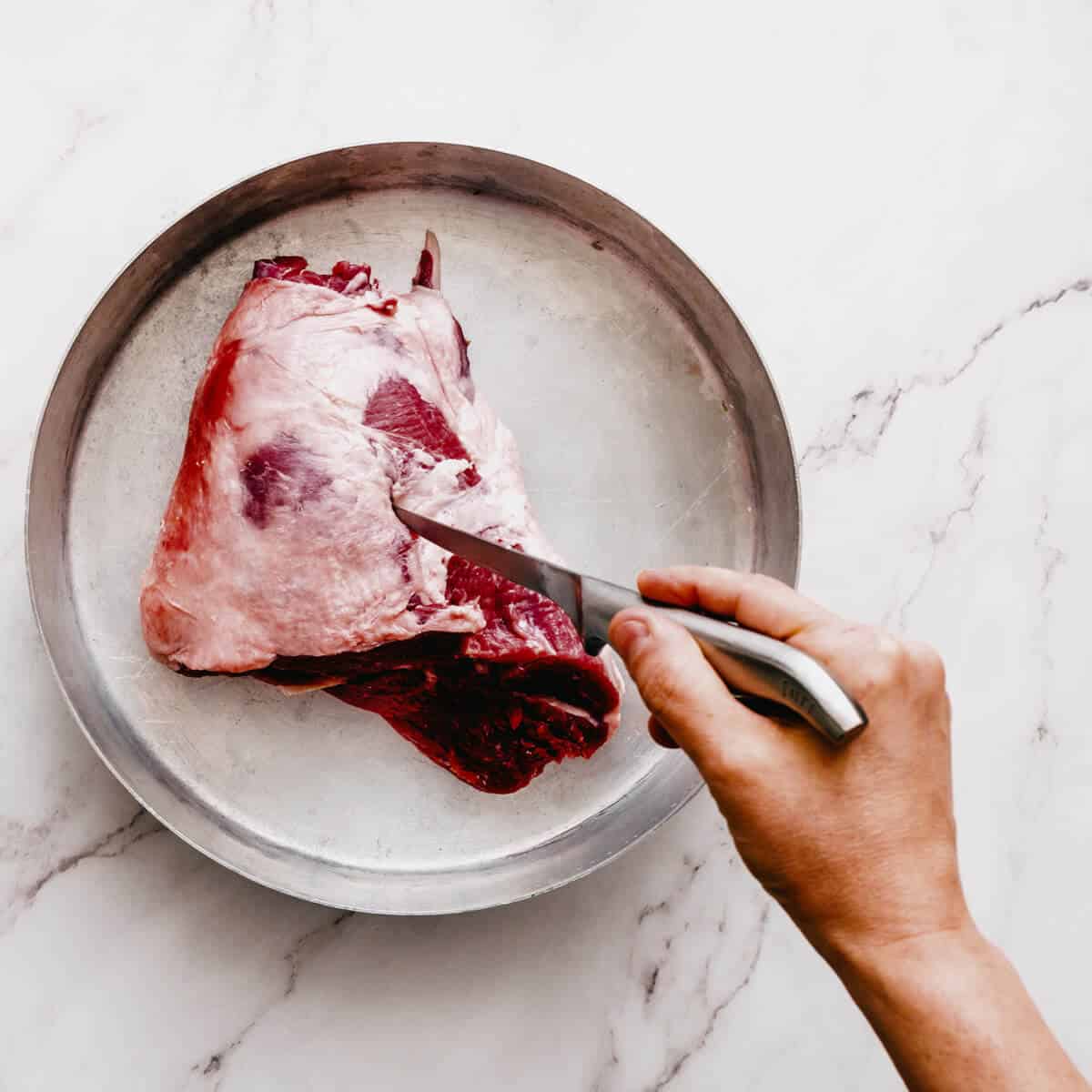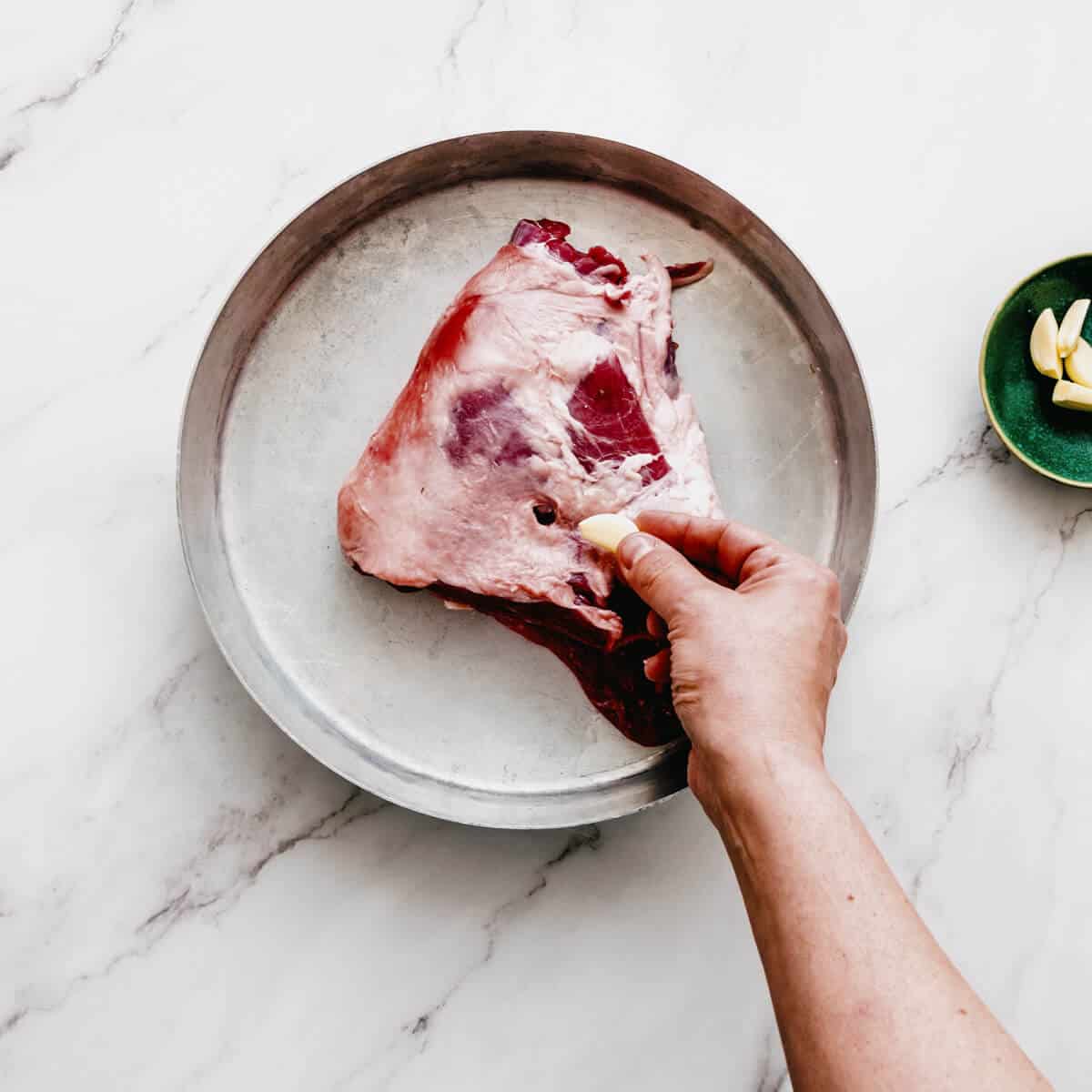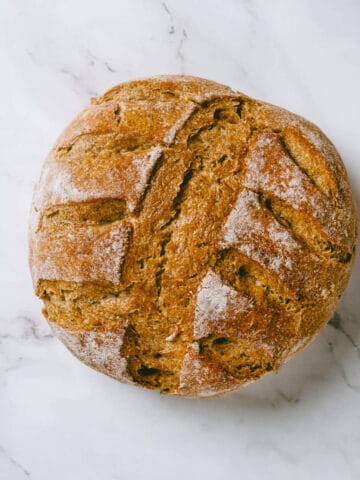Soft, succulent and melt in your mouth - Greek slow roasted lamb is a delicious and easy recipe that you can make at home. The lamb is slow-cooked in a sensational lemon and olive oil sauce, resulting in an incredibly tender and juicy piece of meat.

CONTENTS
Why this recipe works
- Slow roasting is the main aim here. By slowly cooking the lamb - you end up with a delicious dish full of tender meat. Also, don't be put off by how "well done" the lamb looks. Greeks don't like cooking their lamb with a "hint of pink". The slow roasting technique ensures the meat is soft and "melts in the mouth".
- This Greek-style lamb is the perfect dish for entertaining friends and family. Serve it up for a Sunday roast or any other special occasion (Easter Sunday is traditional) and impress your family and friends - you can't go wrong! And don't forget the roasted Greek potatoes on the side - you'll be eating like a real Greek!
- It's packed with flavour. The magic combination of olive oil, lemon juice, oregano and garlic provides this Greek roast lamb recipe with bold flavours. Plus, all these simple ingredients are all-natural and easy to source.
- It's effortless to prepare and cook. It's as simple as marinating, covering and baking. It's low maintenance, and the oven does all the work! This roast lamb recipe is easy!
What goes into this recipe

- Lamb - I'm using a small leg of lamb for this recipe (2 kgs - approx. 4 pounds). I prefer the meat to have the bone in for more flavour. However, you can easily sub with a boneless leg of lamb or use a lamb shoulder or even lamb shanks.
- Garlic Cloves: This ingredient is a MUST! If you find they're too big, cut them down. These are inserted into the flesh to give our Greek lamb maximum flavour.
- Olive oil - I've used Greek extra virgin olive oil. Do not sub with anything else.
- Salt & Black Pepper: Sea Salt is the best! And don't be afraid of using it in this recipe.
- White Wine: A little wine adds a little extra something to our sauce. I also top this up with a bit of water. You can also use chicken stock or chicken broth for an added, intense flavour.
- Fresh Rosemary: A few sprigs of rosemary help spruce this dish up. Consider adding a few pieces of fresh thyme, too - you can't go wrong. If you don't have fresh herbs, consider adding a few teaspoons of dried rosemary and thyme.
- Dried Oregano: Please use real Greek oregano if you can. Don't sub with cheap varieties from the supermarket. For an even more authentic touch, use oregano sprigs if you can find them.
- Lemons - I've used the juice of two lemons for an extra lemon hit! But, for a more subtle taste, go with one.
- Onions - I'm using red onions for extra sweetness, but brown or white ones work well.
Optional add-ons
- Add a few teaspoons of paprika, garlic powder and onion powder to give this Greek slow roasted lamb an extra savoury kick.
How to make this recipe
For the complete recipe, see the recipe card below.

Step 1: Preheat your oven to 220°C/465°F. Start by trimming any excess fat on the leg of lamb. Leave the good bits on top - they will render off and provide delicious flavour to our sauce.

Step 2: Place lamb into your preferred roasting pan. Then, using a sharp knife, cut slits into the lamb's flesh (top, bottom, sides).

Step 3: Insert the garlic into the incisions you've made.

Step 4: Season with salt, pepper, and oregano and rub well into the meat. Drizzle the olive oil and roast in your preheated oven for 30 minutes uncovered).

Step 5: Once it has browned, remove it from the oven and turn it upside-down. Add the onions, rosemary, wine, lemon juice and water (or chicken stock).

Step 6: Cover with parchment paper and cover again with aluminum foil. Turn the oven down to 180°C/350°F and bake for 2 hours - make sure to check it every half hour and baste it with the juices.

Step 7: Remove again from the oven, and add the potatoes (if using) and turn it over. Cover with parchment paper and foil again, and cook for a further 1.5 - 2 hours or until the meat is fall-apart tender.

Step 8: Remove the parchment paper and foil and cook uncovered for 20-30 minutes and allow the meat to brown. Remove again and transfer the slow-cooked lamb to a plate or platter, cover loosely with foil and allow to rest before carving and serving with the sauce.
Related: For another traditional Greek recipe see my makaronia me kima (Greek spaghetti) recipe.
Expert tips
- You'll need a large roasting pan big enough to hold the lamb. Alternatively, you can cook this in a deep casserole dish with a lid.
- Bring the lamb to room temperature BEFORE you start cooking. I like to take mine out of the fridge at least one hour before starting this recipe.
- Start the oven temperature at the highest setting - this will initially help to give the lamb a lovely colour.
- ALWAYS rest the meat when it has finished cooking. Once it's finished cooking, remove the slow-roasted lamb from its baking dish and place it onto a serving platter or cutting board. Cover it with foil. Depending upon the size, this can take up to 30 minutes. The juices will redistribute and make the lamb more flavourful during this time.
- Check on it every half hour while it slowly roasts - this lets you see if your oven is working (don't laugh - it happened to me!). It's also a good time to baste the lamb with all the drippings and juices created in the baking dish.
- If you find it's a little dry during cooking, don't be afraid to add a little water - don't drown it!
- The delicious pan juices, or "zoumi" as it's known in Greek, form an essential part of this Greek slow roasted lamb recipe. Some people choose to strain the fat - but I don't bother! It's also delicious and perfect for dipping your bread in this lovely sauce.
- For a larger piece of lamb, you will need to adjust the cooking times by an extra half an hour. For e.g. if your lamb weigh 2.5 kgs/5 pounds add an extra half an hour to the cooking times in the middle of the recipe (not the initial browning and final cooking).

Serving suggestions
Serve the slow-cooked lamb with my Greek lemon potatoes, a Greek lettuce salad or my Greek salad and some authentic tzatziki sauce for the ultimate Greek feast!
FAQ's
Covering and sealing your baking dish and cooking it for a lengthier time at a lower temperature will help keep the lamb moist.
Lamb legs, lamb shoulders, and lamb shanks are ideal cuts for slow and low methods. However, they're tough, so they need long, slow cooking times.

Related recipes
If you've made this recipe or any other recipe on the blog - don't forget to rate it and leave a comment below. You can also follow the blog on Facebook, Instagram and Pinterest OR sign up to the Newsletter for the latest delicious recipes.
📋 Recipe

Greek Slow Roasted Lamb
Ingredients
- 1 x 2 kgs (4 pounds) leg of lamb, trimmed of any excess fat-at room temperature (see notes 1 &2)
- 8 cloves garlic, peeled
- 2 tablespoon salt
- 1 tablespoon black pepper
- 3 teaspoon oregano, dried, Greek variety
- 2 lemons, juiced
- 60 ml (¼ cup) olive oil, extra virgin, Greek preferable
- 2 onions, quartered
- 4 Rosemary sprigs
- 250 ml (1 cup) white wine
- 250 ml (1 cup) water
Instructions
- Preheat your oven to 220°C/465°F. Start by trimming any excess fat on the leg of lamb. Leave the good bits on top - they will render off and provide delicious flavour to our sauce.
- Place lamb into your preferred roasting pan. Then, using a sharp knife, cut slits into the lamb's flesh (top, bottom, sides).
- Insert the garlic into the incisions you've made.
- Season with salt, pepper, and oregano and rub well into the meat. Drizzle the olive oil and roast in your preheated oven for 30 minutes uncovered. (see note 3)
- Once it has browned, remove it from the oven and turn it upside-down. Add the onions, rosemary, wine, lemon juice and water (or chicken stock).
- Cover with parchment paper and cover again with aluminum foil. Turn the oven down to 180°C/350°F and bake for 2 hours - make sure to check it every half hour and baste it with the juices.
- Remove again from the oven, and add the potatoes (if using). Cover with parchment paper and foil again, and cook for a further 1.5 - 2 hours or until the meat is fall-apart tender.
- Remove the parchment paper and foil and cook uncovered for 20-30 minutes and allow the meat to brown. Remove again and transfer the slow-cooked lamb to a plate or platter, cover loosely with foil and allow to rest before carving and serving with the sauce. (see note 4)
Notes
- For a larger piece of lamb, you will need to adjust the cooking times by an extra half an hour. For e.g. if your lamb weigh 2.5 kgs/5 pounds add an extra half an hour to the cooking times in the middle of the recipe (not the initial browning and final cooking).
- Bring the lamb to room temperature BEFORE you start cooking. I like to take mine out of the fridge at least one hour before starting this recipe.
- Start the oven temperature at the highest setting - this will initially help to give the lamb a lovely colour.
- ALWAYS rest the meat when it has finished cooking. Once it's finished cooking, remove the slow-roasted lamb from its baking dish and place it onto a serving platter or cutting board. Cover it with foil. Depending upon the size, this can take up to 30 minutes. The juices will redistribute and make the lamb more flavourful during this time.
- Check on it every half hour while it slowly roasts - this lets you see if your oven is working (don't laugh - it happened to me!). It's also a good time to baste the lamb with all the drippings and juices created in the baking dish.
- If you find it's a little dry during cooking, don't be afraid to add a little water - don't drown it!
- The delicious pan juices, or "zoumi" known in Greek, are essential for this recipe. Some people choose to strain the fat - but I don't bother! It's also delicious and perfect for dipping your bread in this lovely sauce.
Nutrition
This website provides approximate nutrition information for convenience and as a courtesy only. Nutrition data is gathered primarily from the USDA Food Composition Database, whenever available, or otherwise other online calculators.
© Souvlaki For the Soul
This recipe was first published in May 2013 but was updated with fresh content and pics in May 2022.










Bizzy Lizzy
Love a leg of lamb, Peter. Yours looks succulent and tasty! I cook mine with garlic, lemon juice and olive oil too. ; )
Winston
Lovely! My kinda meal. I love reading about festive seasons celebrated by other cultures. Colleagues shared some treats from over the weekend today and it was delicious. Great hearing about how people celebrated and overate during the weekend.
Rosa
Scrumptious! Those flavors are perfect.
Happy Easter!
Cheers,
Rosa
toula
Looks amazing and i bet it was delicious too. Look forward to your lamb leftover posts.
Christos Anesti 🙂
Sarah Kenney
Beautiful spread! Very very lovely
Gaby Mora
You Greeks do know how to cook lamb. My mouth is watering!
Drbuoux
Hi, Peter--New to your blog (great design photos and writing). I was invited to a Greek Easter celebration on Sunday that did include an entire lamb roasted on a backyard spit--and a whole pig too! Red eggs, tzatziki, semolina bread, lamb brains, sausage and more homemade Greek pastries than I could count. All great stuff. Ken
bellini
Keeping those traditions and family recipes is the way to keep the memories alive, although shaking it up a little is good too.
joannova
Peter - your blog looks terrific and these photos have me drooling. I don't understand why so many people say they don't like lamb. They don't know what they're missing!
Amanda McInerney
Years ago I used to have Greek neighbours and the smell of their Easter lamb used to drive me wild with desire. I can almost smell it again looking at your lovely images, Peter. Thanks.
Niki Floros-Privett
Xristos Anesti. Beautiful photos that made me think of Easters gone by. Of food. Of family and festivities. So glad you're still enjoying that part of you. It shows. x
Maureen
Americans don't eat lamb very often as a rule and I arrived here not having a clue how to slice one. So I didn't roast a leg for a long time. 🙂 Your lamb looks wonderful. Glad the Easter went well and maybe your pants fit now.
The Hungry Australian
Peter, you are killing me with your beautiful, beautiful photos. I can almost smell that lamb from here. Gorgeous post.
Jane's Adventures in Dinner
Nothing better than a lamb roast.
lapiubelladitutte
We did have a nice easter here in Rome as well!
Anna @ The Littlest Anchovy
Man! I wish my lamb roast looked as good as this!! Hope you had a wonderful weekend Peter!
Peter Minaki
From the looks of this leg of lamb, you had a fantastic Easter...Xpistos Anesti!
Diana Athanasatos Jackowski
I cook it the same way however as the lamb rests I put more water in the pan with the drippings and add tomato paste. Then orzo is baked in there for approximately a half an hour or when all the water is absorbed. I know I have two starches but I like the variety.
Niki
This was outstanding. Used a lidded roasting dish for it, gave the the potatoes a squirt of lemon juice and transferred them onto the lid to crisp and brown, along with some asparagus when l uncovered the meat. Because the dish was quite deep and narrow the jus hadn't reduced much so simmered it down while the meat rested. It not only tasted amazing it looked brilliant. Sadly l didn't get a photo of it because some VERY large chunks "fell off" while it was resting. Sorry, not sorry. Absolutely will make again and again.
Peter G
Thank you for the feedback!
Ellen Freitag
I searched the internet for a slow cooked lamb leg recipe and decided to make yours for a Greek dinner party which we hosted last night. Followed the recipe exactly as is and it was absolutely delicious with everyone coming back for seconds and third helpings. Made it with the potatoes (I did take them out of the juices and put them on another baking tray for the last 30 minutes to crisp up) and the Greek lettuce salad. Everyone asked for the recipe. Thank you.